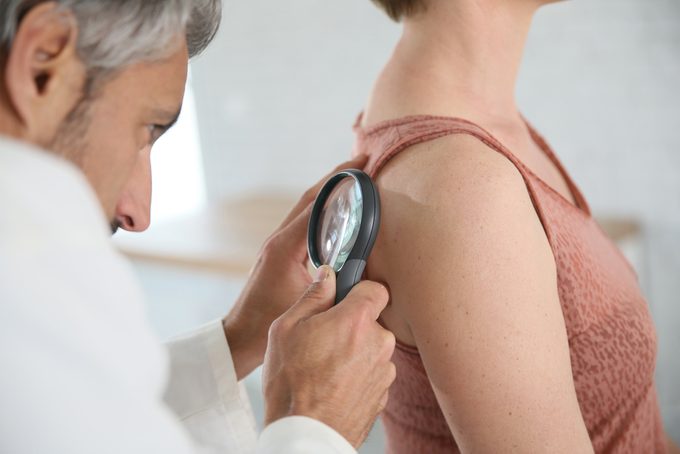What to Expect From a Full-Body Skin Exam
A yearly skin-exam is just as important as your annual physical.

Spot Check
I’m sitting on an exam room table wearing nothing but a paper sheet. It’s not for a Pap smear and pelvic exam (hooray!), but I am undressed and shivering, for a worthy cause. I’m having a skin checkup with Toronto dermatologist Dr. Paul Cohen – a procedure that I know is as important for my health as the annual physical. “A skin check is quick and unobtrusive – and it can save your life,” says Dr. Cohen. And I’m well overdue for mine, especially since I have more than one risk factor for skin cancer. For starters, I had several nasty sunburns as a kid, including one where I recall waking up on a beach blanket with a red-hot bottom. A sunburn from over 25 years ago might not sound very important, but “even one really bad burn from childhood can increase your risk significantly,” says Dr. Cohen.
I also have a family history of skin cancer. My maternal grandfather had several cancerous lesions removed from his arms and hands in his later years. Then there are the more obvious strikes against me: I’m blonde, blue-eyed and fair skinned. Check, check, check.
As a runner, I’m exposed to an extra dose of UV every time I go for a jog. I’m not a serious athlete, but according to Dr. Cohen, this still counts.
Exam Time
As Dr. Cohen inspects my skin, occasionally employing his medicinal magnifying glass and asking questions about my health and lifestyle, I come up with a few traits that can be added to the plus column. For one, I’m a shade worshipper and militant sunscreen user. I apply SPF 30 on my face and any other exposed skin year round, even in minus 30 (as we all should, by the way).
The other thing I have going for me is a decided lack of moles, which I’m told is a good thing. “People with a lot of moles have an increased risk of skin cancer,” says Dr. Cohen. They are also tasked with keeping tabs on them to watch for signs of basal cell carcinoma (which can appear as a reddish bump or pimple-like sore), squamous cell carcinoma (wart-like growths or scaly bumps) or actinic keratoses (scaly spots that can turn into squamous cell lesions).
People also need to be diligent about checking for melanoma, the deadliest form of skin cancer, which can be signaled by growths that emerge as – or turn – brown or black, have a diameter of more than six millimeters, change in colour or shape or size or have an asymmetrical shape or visible border. “If you think something is changing in size, shape or colour, don’t panic, but don’t ignore it,” says Dr. Cohen.
I’m relieved when he gives me a clean bill of skin health, and I’m grateful for the reminder to take good care of my complexion below the neck. Real skincare goes beyond a well-designed facial cleansing and moisturizing routine; it’s about monitoring the health of our body’s biggest organ, from head to toe.
5 Skin Cancer Self-Examination Tips
Toronto dermatologist Dr. Paul Cohen recommends doing skin checks every few months (or more often if you have a lot of moles and it’s recommended by your doctor). Do it after a shower, when you’re already fully disrobed. Simply step in front of a full-length mirror, armed with a hand mirror (for tricky angles, if necessary) and your smartphone, to take up-close pictures of any worrisome spots. (This will help your dermatologist track changes in these areas over time. Just be sure to accurately name and date the photos so that they’re organized for your next visit. Up close, a belly can easily be mistaken for a bum!)
- Begin with your back and calves, the most common places for women to develop melanoma.
- Check anywhere else the sun hits in warmer weather, including your shoulders, arms, the rest of your legs, chest and tummy.
- Examine spots that are always covered. Sun exposure is only part of the equation, so even areas that never see the light of day should be looked at, including your bum, groin and around your breasts.
- Look at your scalp, while your hair is still wet and you can see clearly through your hair.
- Don’t forget your hands and feet. Palms and soles are common problem areas for people with darker skin tones, in particular.
The ABCDEs of Malignant Melanoma
Recognition can aid in early detection. During your self-exam, look at your moles for these features:
Asymmetry
The shape on one side is different than the other side
Border
The border or visible edge is irregular, ragged and imprecise
Colour
There is a colour variation with brown, black, red, grey or white areas within the lesion
Diameter
Diameter growth is typical of melanoma. It’s usually more than 6mm, although it can be less
Evolution
Look for change in colour, size, shape or symptom (i.e. itching, tenderness or bleeding)
Recommended:




